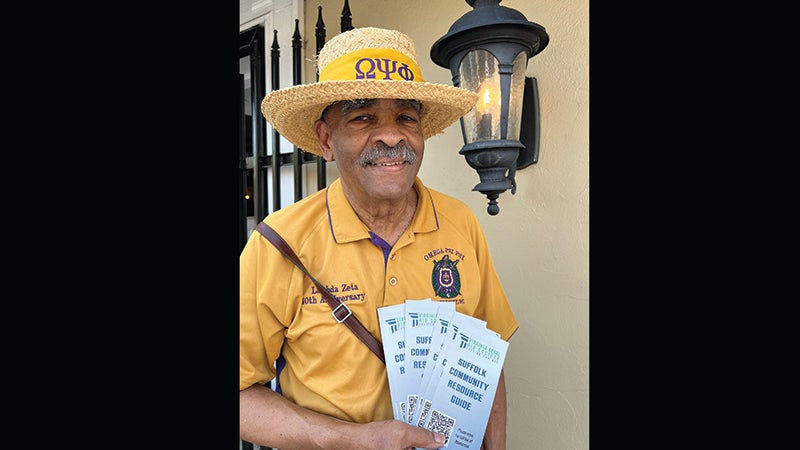How To Make a Good Community Better?
Published 7:02 pm Thursday, September 28, 2023
|
Getting your Trinity Audio player ready...
|
By Phyllis Speidell
Growing up in Suffolk, Harry Lee Cross lll was aware of the divide between the city’s Black and white communities. Now, as a successful Suffolk businessman and community booster, he recognizes that the divide he saw decades ago can still be narrowed. Just maybe, he thought, with so many talented leaders in both communities, great things might be done by working together.
He called Ross Boone, a long-time acquaintance and another Suffolk native, to talk about his inspiration. Boone, a retired educator and community activist, understood Cross’s memories and concerns and was happy to get the call.
“I knew we could work as a team,” Boone said. “What can we do together?”
That same question drew an array of ideas at an initial gathering of community-minded Suffolk residents, including members of the social fraternities and sororities of the Black community. The group brainstormed with Cross and Boone, a life member of the Omega Psi-Phi Fraternity, at the Obici Health Foundation offices in downtown Suffolk.
As a group, they agreed that there are people across Suffolk who are in dire need of help – and that there are numerous agencies that can provide that help. Too often, however, those in need and those who can help are not aware of each other and the needs go unmet.
Ideas flew as individuals in the group mentioned agencies and services they were most familiar with in the city. The list of resources grew as the meeting continued. Gail Trzcinski, Housing and Community Navigator for the Virginia Legal Aid Society, Inc. in Suffolk, volunteered to compile a listing of the suggested agencies and programs and serve as a focal point as more suggestions came in.
That list grew into a plan for a directory of community resources with the group nurturing the project’s growth over the next months. In the past, other groups including the Suffolk Redevelopment and Housing Authority and the Suffolk Partnership for a Healthy Community have compiled listings that are primarily accessible online if the person in need is aware of them and able to access the information.
The new Suffolk Community Resource Guide the group developed is a compact, up-to-date leaflet listing 42 agencies that can help with housing, food, physical and mental health care, legal questions, domestic violence, addictions, veterans’ services, utilities, employment and education.
The group designed the guide to help people in need of immediate help, “the people who need help and need it now,” Cross said.
A QR code on the back of the leaflet connects to a site hosted by the Suffolk libraries and contains additional information on 105 agencies that can provide additional help.
With a first printing of 14,000 copies, the group began distributing the leaflets across the city with requests soon coming in for more copies.
“Our target was to get the guides to people who could give them to people they knew needed help, “ Cross said. “We took them to doctors’ offices, churches, schools, libraries, food banks, the police, and more.”
Boone took the mission another step and went door to door, delivering the guides, – and recruited neighborhood youngsters to help.
The Suffolk Foundation and the Obici Health Care Foundation are two of the project’s supporters. Mary Haddad, an active community volunteer, is a past president of the Suffolk Foundation Board. A Dayton, Ohio, native, she has lived in Suffolk since 1984 when she and her husband were looking for “a good community in which we could raise our four children,” she said. They found Suffolk and Lake Prince and knew they had found their new hometown.
Haddad, echoing the sentiments of Cross and Boone about this community effort, said “We hope to grow this collaborative effort and we’re excited about how the project is going so far – there’s a lot of good energy in this group.”
The leaflet also benefits the agencies who are able and eager to help. Trzcinski said, for example, the Legal Aid Society recognizes the resource leaflet as an unmatched opportunity to make connections and partner with other agencies and community minded individuals to provide the most effective legal support to residents.
Major David Miles, Chief Deputy of the Suffolk Sheriff’s Department, sees another benefit of the group’s cooperative work. He knows the positive value of community engagement in what he terms “the turmoil of the last few years.”
“I think this project is just the beginning – all the people involved are solution minded,” he added “The main thing about this dialogue is the listening.”
He believes this group’s collaboration could also build bridges between what he sees as the city’s three distinct communities – North Suffolk with its growth, downtown Suffolk with its history and rural Suffolk with its agriculture – and their resources.
Boone and Cross share his optimism, foreseeing that by networking through their varied contacts, experiences and expertise, the Suffolk Community Resource Guide group can involve others, take on other cooperative projects and create a stronger connection between residents across the greater Suffolk area – making a good community even better.





